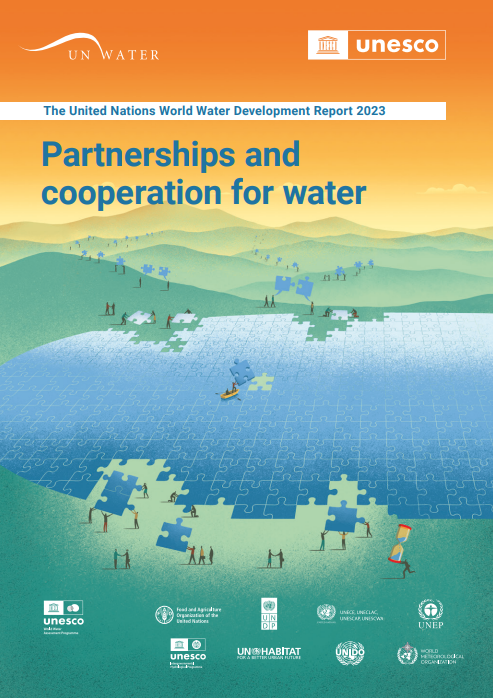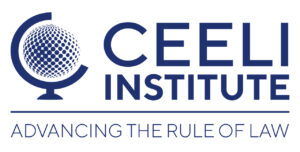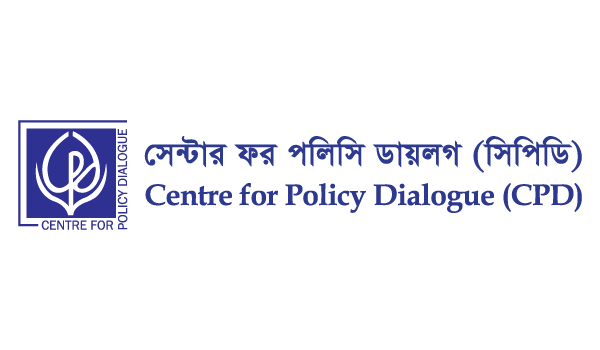The 2023 UN World Water Development Report underscores the necessity for worldwide cooperation to fulfil the human right to water and sanitation. Thus, the report proposes a multi-layered, cross-sectoral strategy that includes governments, businesses, civil society, and various stakeholders. In addition, the limitations of traditional bilateral water-sharing agreements are outlined, calling for a broader range of participants. Also, it acknowledges potential barriers to collaboration, such as distrust, power disparities, and institutional fragmentation and suggests solutions like open data sharing, capacity building, and simplified regulations.
Key findings and highlights:
- Partnerships and Cooperation: stresses the need for partnerships and improved cooperation in all aspects of sustainable water management. These partnerships are crucial to addressing the water crisis and achieving SDG 6.
- Health, Education, Climate Change, and Gender Equality: discusses ways the water and sanitation community can collaborate more effectively in these critical areas, which are integral to achieving SDG 6.
- International Cooperation and Capacity-Building Support: advocates for expanded international cooperation and capacity-building support in water-related areas, such as water harvesting, desalination, water efficiency, wastewater treatment, recycling, and reuse technologies.
- Water Action Decade: endorses the International Decade for Action on “Water for Sustainable Development 2018–2028”. It emphasizes the need for increased dedication and action from governments, industries, and stakeholders to achieve the 2030 Agenda and its water-related targets.
Some proposed solutions:
In this sense, the UN World Water Development Report 2023 suggests a practical solution: enhanced collaboration across all levels. Governments, businesses, and civil society should come together to:
- Develop innovative financing mechanisms: Public-private partnerships, blended finance models, and green bonds can unlock the resources needed to bridge the funding gap.
- Build capacity and share knowledge: Training programs, technology transfer initiatives, and south-south cooperation can empower communities and countries to manage their water resources effectively.
- Foster a culture of collaboration: Inclusive dialogue platforms, joint research partnerships, and knowledge-sharing networks can break down silos and amplify the impact of individual efforts.
Key statistics:
- Access to safe drinking water: Approximately 2 billion people (26% of the world’s population) do not have safe drinking water.
- Access to safe sanitation services: Around 3.6 billion people (46% of the world’s population) lack access to safely managed sanitation services.
- Urban water scarcity: Water scarcity in urban areas is expected to worsen, as the projected population doubling in 2050 will further strain water resources.
- Progress towards SDG 6: At current rates of progress, the Sustainable Development Goal (SDG) 6, which aims to ensure the availability and sustainable management of water for all by 2030, will not be achieved by 2030.
Moreover, the report paints a stark picture of the challenges faced:
- 6% of global GDP at risk: Water scarcity could cost us a staggering 6% by 2050, a chilling reminder of the economic consequences of inaction.
- US$650 billion funding gap: Achieving the Sustainable Development Goals for water and sanitation by 2030 requires an annual investment of US$650 billion, highlighting the urgent need for innovative financing mechanisms.
- 2.4 billion without safe water, 4.2 billion without adequate sanitation: These numbers are a clarion call, reminding us that millions globally face daily struggles due to the lack of essential water and sanitation needs.
Partnerships beyond sectors:
Notably, it dissects partnerships across various planes:
- Governments: Transboundary water challenges demand international collaboration. Think of joint infrastructure projects for shared rivers, knowledge exchange on water management practices, and coordinated responses to droughts and floods.
- Public-Private Partnerships: The private sector’s expertise and resources can be vital allies. Imagine public agencies partnering with private companies to develop innovative water treatment technologies, finance sustainable sanitation solutions, and build resilient water infrastructure.
- Civil Society Engagement: Leaving communities and indigenous groups out of the equation is a recipe for failure. The report champions partnerships that include the voices of those most affected by water issues, ensuring equitable access, promoting water stewardship practices, and fostering local ownership of solutions.
Hence, the UN World Water Development Report 2023 broadens its focus, underscoring the importance of agriculture, industry, and energy partnerships. Sustainable water use within these sectors is vital for attaining water security and overall developmental objectives.
Sections
Chapter 1
Focuses on the importance of partnerships and cooperation for water management. It provides an overview of global freshwater resources and progress towards Sustainable Development Goal 6 (SDG 6) on water and sanitation. Additionally, the chapter identifies water-dependent sectors and outlines the five ‘accelerators’ under the SDG 6 Global Acceleration Framework: Education and Capacity Development, Data and Information, Innovation, Funding, and Governance.
Chapter 2
Emphasizes the importance of partnerships and cooperation in addressing water-related challenges in the agricultural sector. Building on this, the chapter explores the interconnection between water, agriculture, and food security, the impact of water scarcity and quality on agricultural productivity, and the role of partnerships in promoting water-efficient practices. It highlights the need for collaborative efforts in managing water resources sustainably and provides case studies of successful partnerships in food and agriculture.
Chapter 3
Stresses the importance of ecosystem services for sustainable water management, the impact of climate change and pollution on water resources, and the role of biodiversity. Furthermore, it underscores the need for partnerships and cooperation in promoting sustainable environmental management, providing case studies as examples.
Chapter 4
Underlines the importance of access to safe and sustainable water and sanitation services. Additionally, it discusses the role of water operators’ partnerships, effective wastewater management, multistakeholder partnerships in rural and secondary towns, strategies for enhancing water resilience in cities, and the specific needs of migrants and refugees. Lastly, the chapter also highlights the role of partnerships and collaborative efforts in addressing these needs.
Chapter 5
Discusses the significance of sustainable water use in the industrial sector. In addition, it explores industrial water use patterns and challenges, the motivations for collective action to address water-related issues, and the elements of such actions. Furthermore, it provides examples of successful industry collaborations for sustainable water management.
Chapter 6
Emphasizes the critical role of water in maintaining human health and the impact of water-related diseases. Moreover, it discusses the challenges to achieving universal access to safe water, particularly in low- and middle-income countries, and explores the role of multistakeholder partnerships in addressing these issues. Additionally, it presents case studies of successful initiatives to improve water and health outcomes.
Chapter 7
Discusses the impact of climate change on water resources, the importance of water resilience and adaptive strategies, and the role of water in climate change mitigation. Furthermore, it emphasizes the significance of multistakeholder partnerships in promoting water resilience and provides case studies of successful initiatives.
Chapter 8
Addresses regional challenges and opportunities in water resources management and water and sanitation services provision. Notably, it emphasizes the role of regional cooperation and multistakeholder partnerships in addressing these challenges and promoting sustainable practices. Moreover, it provides case studies of successful initiatives in various regional contexts.
Chapter 9
Spotlights the critical role of education and capacity development in sustainable water management. Additionally, it discusses various education and training programs, the concept of knowledge co-creation, and the importance of lifelong learning. For instance, it also presents case studies of successful initiatives that have effectively promoted sustainable water management practices.
Chapter 10
Underscores the importance of data, information, and monitoring in water resources management. Additionally, it discusses data collection and sharing challenges, the role of monitoring systems, data-driven approaches, and collaborative initiatives to improve data practices. Importantly, the chapter emphasizes the need for reliable data to support evidence-based decision-making and sustainable water management.
Chapter 11
Emphasizes the role of innovation in water resources management. It highlights the importance of technological innovations like remote sensing and data analytics, social innovation involving stakeholder engagement and knowledge co-creation, and innovation in governance, financing, and education. Likewise, it underscores the need for a holistic approach to innovation to enhance water management practices and achieve sustainable development goals.
Chapter 12
Discusses the financing challenges in water management and the need for innovative solutions. Furthermore, it emphasizes the importance of cooperation among stakeholders, financial institutions, and governments. Additionally, the chapter highlights the need to align the supply and demand sides of finance and use innovative financial instruments to ensure sustainable financing for water-related initiatives.
Chapter 13
Underlines the need for inclusive and collaborative water resource management. Moreover, it highlights the importance of enhanced cooperation over water, food, and climate security, meaningful participation of diverse stakeholders, strategic integration and cross-sectoral coordination in multi-use water systems, and the potential of public-private partnerships. For example, the chapter advocates for a whole-of-society partnership approach to water governance.
Chapter 14
Underscores the importance of a ‘whole-of-society’ approach to water governance and the critical role of multistakeholder partnerships in achieving sustainable water management. Finally, it underscores the need to integrate water-related goals into broader sustainable development agendas, such as addressing water resilience in the face of urbanization, migration, and climate change and promoting innovative water supply and sanitation approaches.




